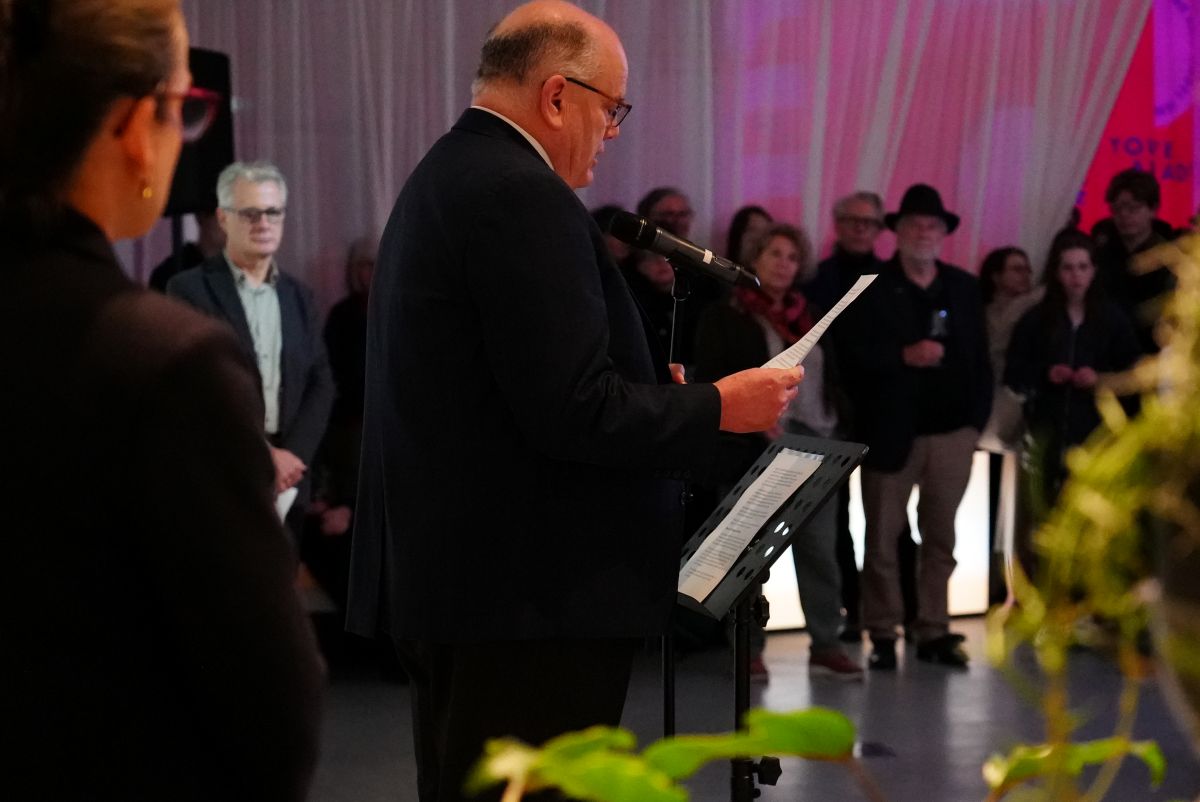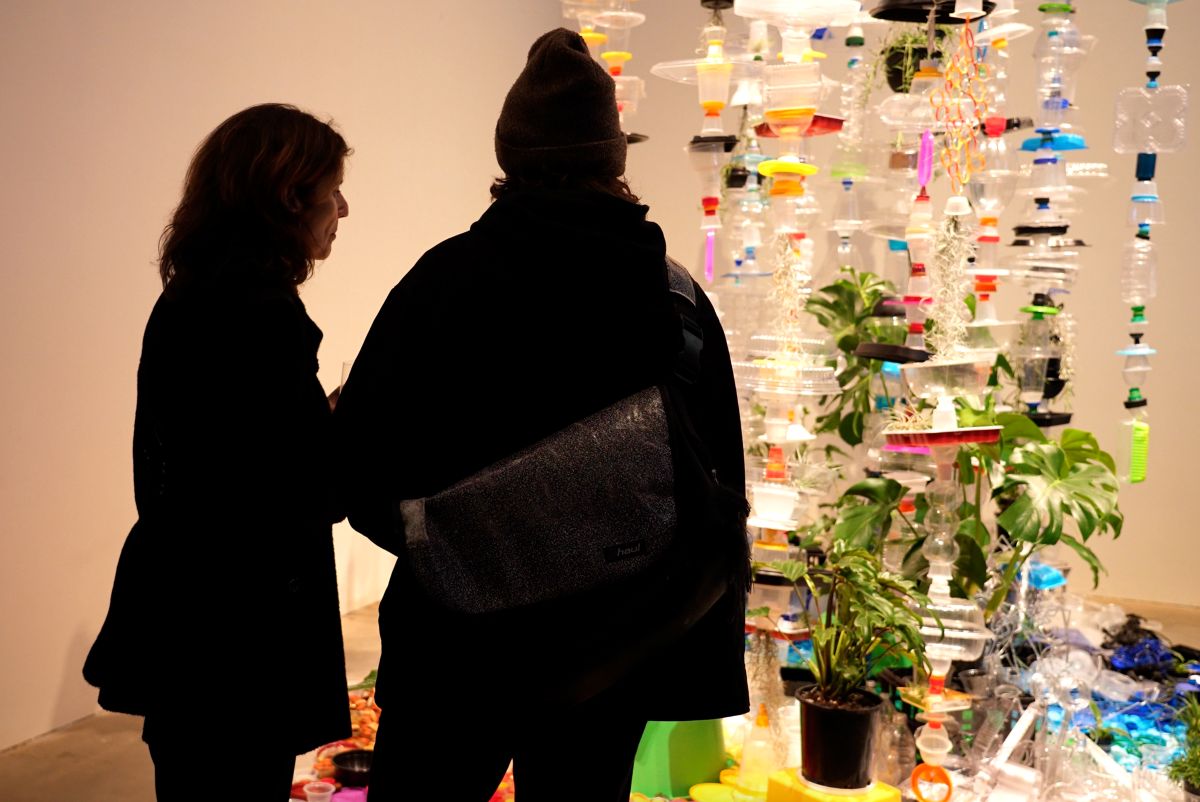The RMIT recently held an exhibition titled "The Mourning After". The opening address was given by Chris Hall, CEO of Grief Australia. Chris spoke about grief not only being for those we have lost, but for disappearing landscapes, extinct species, lost languages, fractured communities and fading certainties. He talked about grief no longer happening in silence in this era of digital connectivity, with strangers bearing witness to other's grief and sorrow being scaffolded by solidarity. Chris' address captivated everyone at the opening.
Given grief is such an integral part of palliative care Chris has kindly shared his address with our community.

Chris Hall at The Mourning After opening
Acknowledgment of Country
Before I begin, I want to take a moment to acknowledge the Woi wurrung and Boon wurrung peoples of the Eastern Kulin Nation, the Traditional Custodians of the unceded land we are gathered on this evening.
I respect their enduring connection to this place - its lands, its waters, and its stories. That connection has held strong through generations, and it continues to shape this country in profound ways.
I pay my respects to Elders, past and present, and I also bear witness to the deep grief carried by their people, born of injustice and loss, and are moved by their extraordinary strength, resilience and spirit in the face of these enduring hardships. I honour that strength, that legacy and the living culture that surrounds us.
Introducing the Exhibition
It is an honour to stand before you this evening to open The Mourning After, an exhibition that does not merely explore grief but reimagines it as a force of transformation, connection and renewal. This exhibition is a testament to the courage of artists, designers, activists, academics and audiences to engage deeply with and reimagine loss - not as an end, but as a continuing presence in our lives.
Grief is often framed as something to be endured, managed or ‘moved on from’. But what if we looked at grief differently? This exhibition invites us to see grief differently, not as an end, but as a presence, a process, and, at times, a provocation.
What if we viewed grief as a dynamic, evolving relationship, one that not only reshapes our identities but also transforms our social and cultural landscapes. One that also reshapes the natural and built environments that we call home? This is precisely what The Mourning After invites us to do.
As part of an Australian Research Council Future Fellowship, The Mourning After examines mourning rituals across multiple dimensions - personal, cultural, and ecological. It brings together artists, designers, activists and scholars to explore loss from the perspectives of First Nations wisdom, climate grief, bereavement, digital mourning and digital media.
In a world marked by crisis and change - climate devastation, technological acceleration, social and political upheaval - our ways of grieving are shifting and evolving. We grieve not only for those we have lost, but for disappearing landscapes, extinct species, lost languages, fractured communities, and fading certainties.
This exhibition challenges us to rethink grief, not as an isolated experience but as a profoundly collective one, one that shapes how we care for each other and our world.
This exhibition reminds us: grief is no longer silent. It is broadcast. It is digitised. It is public. And crucially, it is political.

One of the art exhibitions
Themes of Technology and Bonding
One of the most resonant themes explored here is how technology reshapes our experience of grief. Social media and mobile platforms have transformed mourning into a shared, public practice, dissolving the boundaries between private sorrow and communal solidarity.
We find ourselves scrolling through memorial posts, watching digital candles flicker, and engaging in rituals that never existed before, and yet now hold profound meaning. Online platforms have become spaces where strangers bear witness to each other’s pain, offer support, create new rituals of remembrance and where the public and private intermingle.
In an era of digital connectivity, grief no longer happens in silence - it echoes, gathers and creates networks of connection and meaning across distances.
This is not disconnection. It is a new form of intimacy. In these digital networks, strangers bear witness, and sorrow is scaffolded by solidarity.
Another crucial idea explored here is the continuing bonds of grief. This challenges the outdated notion that mourning is about “moving on” and “letting go”. Instead, it suggests that the deceased remain with us, not in the past, but as an ongoing presence in our lives.
Whether through ritual, storytelling, or creative expression, grief enables us to maintain relationships beyond death, integrating those we have lost into our present and future. Instead, it affirms what many cultures have always known: the dead do not disappear.
They walk with us in story, symbol, song and soil. Through ritual, creativity, and love, we maintain relationships that transcend time.
Grief as a Catalyst for Civic Change
But The Mourning After is more than a space for reflection, it is a call to action. Through immersive works and engaging workshops, we are confronted by questions, such as How can we transform grief into a catalyst for change? How can our mourning practices contribute to sustainability, justice and kinship?
This exhibition dares us to see loss not as an endpoint but as a generative force, one that can inspire new forms of connection and care.
Grief is no longer a purely personal matter. It is a public health issue. Grief impacts our physical, emotional, and social wellbeing. It shapes how we engage in community, how we vote and how we care.
As you move through the exhibition, I encourage you to engage with these works not only as observers but as participants. Let them challenge you, comfort you, provoke you. Let them serve as a powerful reminder that grief is not just a private burden carried within. It is a shared experience, a cultural force, and a collective reckoning that connects us all.
Closing
Tonight, we do more than open an exhibition. We ignite a conversation. One that will echo through corridors of power, around kitchen tables, and within the quiet recesses of memory. It is an invitation to honour loss not as absence, but as presence - and from that reverence, to shape something tender, lasting, and profoundly human.
Let us imagine what comes after mourning. Not a return to normal, but a re-making of the world with more care, more courage and more kinship.
With that, it is my great pleasure to declare The Mourning After exhibition officially open.
Thank you.
Further information about this exhibition hosted by RMIT
About Grief Australia
Grief Australia is the nation’s leading authority on grief and bereavement, and a recognised global leader in evidence-informed counselling, education, and research. We are dedicated to supporting grieving Australians while shaping a more compassionate and effective national response to grief.
About Christopher Hall
Mr Christopher HALL AM, JP, MA, GradDipAdol&ChPsych, BEd, CertIVTAE, MAPS, GAICD, FAIM, FIWGddb
For the past 29 years Christopher Hall has held the position of Director and Chief Executive Officer of Grief Australia, the Victorian government funded specialist bereavement service. He is a psychologist who has developed a specialisation in the field of grief and bereavement over the past 35 years. In the 2024 King’s Birthday Honours Christopher was appointed a Member of the Order of Australia, (AM) for significant service to psychology, particularly to grief and bereavement.